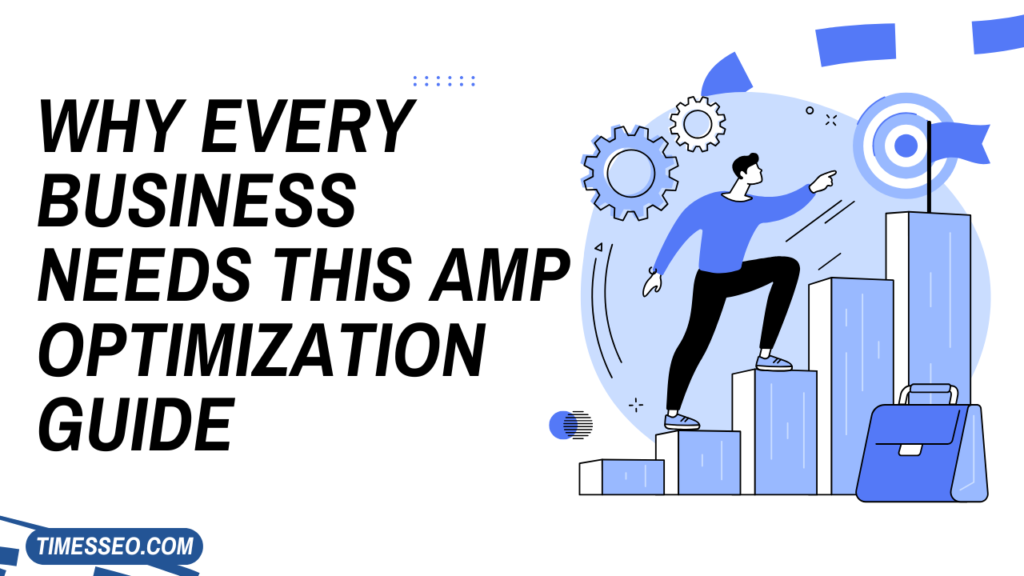
Why Every Business Needs This AMP Optimization Guide
The blog post “Why Every Business Needs This AMP Optimization Guide” explains how Accelerated Mobile Pages can boost website speed, improve SEO, and enhance user experience. This comprehensive AMP optimization guide highlights benefits, implementation tips, best practices, and common mistakes to help businesses maximize mobile performance and conversions.
Table of Contents
Introduction
What is AMP?
A Google-led open-source technology called AMP, or Accelerated Mobile Pages, was created to help mobile web pages load nearly instantaneously. It’s a simplified, performance-first approach that strips unnecessary elements and focuses on delivering core content as quickly as possible.
The Growing Need for Mobile Speed
In today’s digital market, over half of web traffic comes from mobile devices. Slow load times cost businesses potential leads, sales, and brand credibility. By providing incredibly quick, mobile-friendly versions of your website, AMP fills the gap.
Why AMP is a Game-Changer for Businesses
Mobile-First Era and User Expectations
Your customers expect speed. In today’s mobile-first environment, even a one-second delay can drive visitors to your rival’s website. AMP guarantees that your company continuously satisfies such standards.
The Connection Between Speed and Conversions
Research shows faster sites convert better. Whether it’s completing a purchase, filling out a form, or reading an article, AMP’s instant load speed keeps users engaged.
SEO Advantages of AMP
Google favors fast, mobile-optimized pages, often ranking AMP pages higher in mobile searches and featuring them in rich results.
Core Benefits of Implementing AMP
Lightning-Fast Load Times
AMP strips away heavy scripts and optimizes delivery, ensuring near-instant loading.
Enhanced Mobile Experience
With smooth scrolling, responsive layouts, and quick transitions, AMP makes mobile browsing effortless.
Increased Engagement and Reduced Bounce Rates
When your site loads instantly, visitors stay longer, explore more, and interact with your business.
Better Search Visibility
AMP can boost rankings, click-through rates, and visibility in Google’s mobile results.
How AMP Works for Business Websites
AMP HTML and Its Role
AMP uses a restricted form of HTML with special tags optimized for performance.
AMP JavaScript for Speed Optimization
It manages resource loading, prioritizing only the most critical elements for the user.
AMP Cache for Instant Delivery
Google’s AMP Cache stores and serves AMP pages directly from its servers, speeding up delivery even further.
Implementing AMP in Your Business Website
Choosing the Right AMP Tools and Plugins
Official AMP Plugin for WordPress
Best for businesses seeking a straightforward, supported solution.
AMP for WP Plugin
Provides more customization, ad integration, and flexibility.
Custom AMP Development
For businesses with unique requirements, developers can build custom AMP templates.
Best Practices for AMP Optimization
Optimize Media Assets
To reduce load times, use <amp-img> tags and compressed images.
Keep Design Clean and Functional
Avoid heavy design elements that slow AMP performance.
Structured Data for Rich Results
Add schema markup to enhance search result appearance.
Analytics Integration for AMP Pages
Connect AMP to Google Analytics to track engagement, conversions, and other KPIs.
Measuring the Impact of AMP on Your Business
Key Performance Indicators (KPIs) to Track
Monitor bounce rates, average session duration, and conversion rates before and after AMP implementation.
Using Google Analytics and Search Console
Track organic traffic growth, search impressions, and AMP-specific performance data.
Common AMP Mistakes to Avoid
Overcomplicated Designs
AMP thrives on simplicity—avoid bloated elements that harm speed.
Missing Canonical Tags
Always connect AMP pages to their original URLs to avoid duplicate content issues.
Ignoring Validation Errors
Fix AMP errors promptly to ensure full functionality and search indexing.
When AMP May Not Be the Right Choice
Limitations for Highly Interactive Sites
Sites reliant on heavy JavaScript or complex user interactions may find AMP limiting.
Alternative Speed Optimization Methods
Consider PWAs, responsive design, or server-side optimization if AMP isn’t suitable.
Conclusion
AMP can be a transformative tool for businesses aiming to dominate mobile search, improve customer satisfaction, and boost conversions. By following best practices and avoiding common pitfalls, you can make AMP a powerful asset in your digital strategy.
Frequently Asked Questions
Yes, many e-commerce brands use AMP to speed up product and checkout pages.
AMP works well for most, but interactive or complex sites may face limitations.
Indirectly—by improving speed and user experience, AMP can help rankings.
Not at all—plugins make AMP setup quick and easy.
Yes, AMP supports ads, though customization options may be limited.
Table of Contents
Popular Posts
-
 Affordable Technical SEO Audit for Small Business: A Complete Guide26 Jun 2025 SEO Audits
Affordable Technical SEO Audit for Small Business: A Complete Guide26 Jun 2025 SEO Audits -
 How to Get an Affordable Technical SEO Audit for Small Business27 Jun 2025 SEO Audits
How to Get an Affordable Technical SEO Audit for Small Business27 Jun 2025 SEO Audits -
 The Ultimate Local SEO Audit Checklist for Startups28 Jun 2025 SEO Audits
The Ultimate Local SEO Audit Checklist for Startups28 Jun 2025 SEO Audits -
 Local SEO Audit Checklist for Startups: A Beginner’s Guide28 Jun 2025 Affiliate Marketing
Local SEO Audit Checklist for Startups: A Beginner’s Guide28 Jun 2025 Affiliate Marketing -
 Top On-Page SEO Audit Steps for Service Websites Every Business Should Know29 Jun 2025 Affiliate Marketing
Top On-Page SEO Audit Steps for Service Websites Every Business Should Know29 Jun 2025 Affiliate Marketing -
 Technical SEO for WordPress: The Ultimate Beginner’s Guide01 Jul 2025 Affiliate Marketing
Technical SEO for WordPress: The Ultimate Beginner’s Guide01 Jul 2025 Affiliate Marketing -
 The Impact of On-Page SEO Audit Steps for Service Websites on UX01 Jul 2025 On Page Seo
The Impact of On-Page SEO Audit Steps for Service Websites on UX01 Jul 2025 On Page Seo -
 Technical Mobile SEO Audit Tips for Developers02 Jul 2025 Affiliate Marketing
Technical Mobile SEO Audit Tips for Developers02 Jul 2025 Affiliate Marketing -
 Complete SEO Backlink Audit Guide for Better Google Rankings03 Jul 2025 SEO Audits
Complete SEO Backlink Audit Guide for Better Google Rankings03 Jul 2025 SEO Audits -
 Boost Your Rankings with Technical SEO for WordPress01 Jul 2025 Technical Seo
Boost Your Rankings with Technical SEO for WordPress01 Jul 2025 Technical Seo






